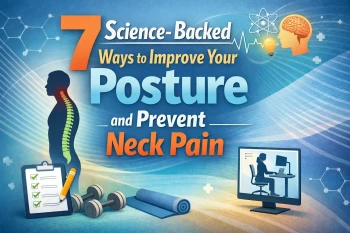
The upper cervical spine is a very significant part of the body as it protects our brain stem and allows the brain to body communication to work properly. Without a proper brain to body communication, many problems can arise throughout our body.
Whiplash can cause more injury to your upper cervical spine than you know and it is important to understand how an injury to the upper cervical spine also relates to the connection between Meniere’s disease and whiplash if you are looking for an effective treatment.
What Makes the Upper Cervical Spine Disrupt Brain to Body Communication?
The cause of disrupting brain to body communication is in the vertebrae that protect the brain stem. If any of the vertebrae in the upper cervical spine fall out of alignment, they can apply pressure to your brain stem and this pressure begins to distort your body’s signals.
The misalignment can be caused by a variety of things: falls, accidents, strains, poor posture, and the natural aging process. In fact, after experiencing whiplash from an automobile accident or contact sports, not many people think of checking up on their upper cervical spine right away.
Whiplash is a very common cause of an upper cervical misalignment.
When the vertebrae press up against your brain stem, it can affect blood pressure, your brain’s oxygen intake (creating more headaches and migraines), slow down its repairing and healing process, increase your chances of becoming sick, and make you vulnerable to more conditions.
At times, this can become severe enough to where your system begins to attack healthy cells instead of targeting foreign invaders – breaking down numerous parts of your body’s defense systems.
What is Meniere’s Disease?
Meniere’s disease is a disorder of the inner ear. This disorder will cause impulsive episodes of vertigo as well as tinnitus (ringing in the ears), fluctuating hearing loss, and a feeling of pressure or fullness in the ear. Among all symptoms of Meniere’s disease, vertigo is the most troubling.
Vertigo is a false sensation that you or the environment around you is spinning. It can affect your balance and make you feel nauseous. Vertigo can last anywhere from 10 minutes to as much as 24 hours. Even when vertigo dissipates, most will feel fatigued and feel imbalanced for up to two days before feeling normal.
How Does Whiplash Cause Meniere’s Disease?
It is not uncommon for whiplash to be the trigger for Meniere’s disease. There is a connection between Meniere’s disease and whiplash and to spot the connection, we look to your upper cervical spine.
Since Meniere’s disease is a disorder of the inner ear, what does whiplash have to do with it?
Whiplash occurs when the neck area is harmed. This could be from contact sports, automobile accident, or any other incident in which the head experiences a quick, forceful back and forth motion.
Whiplash can cause your upper cervical spine, located in your neck area, to fall out of alignment. The vertebrae that are out of alignment can then cause pressure on your brain stem and other nerves or soft tissue; however, it is important to note that when your upper cervical spine changes alignment, other parts follow its lead.
The small, middle ear bones can begin to shift and change due to the upper cervical spine changing position. What will also change is natural functions, such as ear drainage and how your body perceives signals.
When the upper cervical spine is out of place and presses up against your brain stem, it distorts communication and causes your natural functions to become inadequate.
This means the fluid in your ear can begin to build up and the feeling of pressure may occur in your ear. In addition, when the small bones shift in your inner ear, the crystals that help your body determine balance and outside signals change position.
Since your balance is now affected due to the crystals in your inner ear being dislodged, vertigo becomes a symptom as well as tinnitus.
Upper Cervical Spine Treatment for Meniere’s Disease and Whiplash
The upper cervical spine plays a large role in Meniere’s disease and whiplash. The connection between Meniere’s disease and whiplash is strong, as whiplash can cause an upper cervical misalignment that leads to inner ear problems.
The symptoms associated with Meniere’s disease can be targeted with upper cervical spine treatment while the treatment helps take care of the underlying issue.
The most known treatment options for Meniere’s disease happen to focus on relieving the patients of their symptoms – not the cause of their symptoms.
Since we know Meniere’s disease and whiplash do have a connection and whiplash causes misalignments to occur in the upper cervical spine, it is the upper cervical spine that should be treated properly.
Treatments that target only the symptoms look over this Meniere’s disease and whiplash connection.
Upper cervical spine treatments are effective even after the use of other treatment options because of how it focuses on the involvement the upper cervical spine has with the Meniere’s disease and whiplash link.
Remember, the only reason there is a link is because of an issue with the upper cervical spine that occurs after whiplash.
Upper cervical treatments are very gentle, precise adjustments suitable for any age. Patients have reported noticing an improvement to their condition in as little as one adjustment – even if they have experienced surgery beforehand.
This is because other treatments do not aid the body in its natural healing and repairing process.
When the upper cervical spine is corrected, other parts of your body will begin to shift into proper alignment such as the bones in your middle ear and the brain to body communication is restored now that pressure is taken off your brain stem and which allows your body to heal and repair injured areas naturally.
If you or a loved one suffer from Meniere’s disease, keep in mind the link it has to whiplash.
Upper cervical adjustments are an all-natural way to help treat injuries you may suffer from after experiencing whiplash and help your body become healthier overall by bringing back natural functions and brain to body communication.




Leave a comment